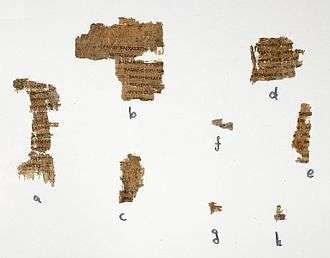Papyrus Rylands 458
Papyrus Rylands 458 (TM 62298; LDAB 3459) is a copy of the Pentateuch in a Greek version of the Hebrew Bible known as the Septuagint. It is a papyrus manuscript in roll form. The manuscript has been assigned palaeographically toward the middle of the 2nd century BC,[1] and before the discovery of the Dead Sea Scrolls it was the oldest known manuscript of the Greek Bible. The manuscript has survived in a very fragmentary condition.

Description
The text was written on papyrus in uncial letters. It is designated by the number 957 on the list of Septuagint manuscripts according to the numbering system devised by Alfred Rahlfs. The surviving texts of the Book of Deuteronomy are Deut 23:24(26)–24:3; 25:1–3; 26:12; 26:17–19; 28:31–33; 27:15; 28:2.[2]
The manuscript consists of only 8 small fragments, designated by the letters "a"–"h". Fragment "h" is the smallest and contains only two letters. The words are not divided by spaces, but written continuously. The writer uses the colorimetric system, regularly leaving a space at the end of sentence or clause.[2]
The text of the manuscript agrees more with Washington Manuscript I (WI) or Codex Alexandrinus than with Codex Vaticanus.[3]
Tetragrammaton
The manuscript has been used in discussions about the Tetragrammaton, especially as there are blank spaces in the places where some scholars, such as C. H. Roberts, believe it contained letters.[4] According to Paul E. Kahle, the Tetragrammaton was written in the manuscript where these breaks or blank spaces appear and subsequently removed.[5] Historian Françoise Dunand says that "as in Papyrus Fouad 266, P. Rylands 458 of Deuteronomy probably had the Tetragrammaton written either in square Hebrew or in archaic characters..."[6] Another possibility is that the primary scribe left blanks for another to fill in later, like in Papyrus Oxyrhynchus 656;[7] Martin Rösel states that "here we find a gap in Deut. 26.18 where one would expect either κύριος or the tetragrammaton. This gap is large enough to accommodate both words, and it seems likely that the scribe of the Greek text left the space free for someone else to insert the Hebrew characters of the tetragrammaton."[7]
On the significance of the gaps in P. Ryl. 458, Albert Pietersma since 1984 has asserted that the evidence from this manuscript (MSS) has been overemphasized, "not because it is relevant to our discussion, but because it has been forcibly introduced into the discussion, in part, one surmises, because it is the oldest extant LXX MSS".[8]:91 He adds with some irony, "One hopes that this text will henceforth be banned from further discussion regarding the tetragram, since it has nothing to say about it".[8]:92
History of the scroll
Palaeographically the manuscript has been assigned to the mid-2nd century BC. It is the oldest known manuscript of the Septuagint. It is believed it came from Fayyum, where there were two Jewish synagogues.[2]
The manuscript was discovered in 1917 by J. Rendel Harris. It was examined by A. Vaccari (1936) and A. Pietersma (1985).[2] The text was edited by C. H. Roberts in 1936.[9][10]
The manuscript is currently housed at the John Rylands Library (Gr. P. 458) in Manchester,[2] giving the manuscript its name.
See also
References
- George Howard (1971). "The oldest Greek text of Deuteronomy". Hebrew Union College Annual. Jewish Institute of Religion: Hebrew Union College Press. Vol. 42: 125–131. JSTOR 23506719.
- Würthwein Ernst (1988). Der Text des Alten Testaments, Stuttgart: Deutsche Bibelgesellschaft, p. 190.
- "Bible manuscripts", Rylands Papyri, UK: Katapi.
- Sidney Jellicoe (1968). The Septuagint and Modern Study. Eisenbrauns. pp. 271–2. ISBN 0-931464-00-5.
- Paul E. Kahle (1959). The Cairo Geniza. Oxford: Basil Blackwell. p. 222. ISBN 0758162456..
- Françoise Dunand (1966). "Papyrus grecs bibliques (Papyrus F. inv. 266): volumina de la Genèse et du Deutéronome: introduction". JSCS. Publications de l'Institut français d'archéologie orientale du Caire.; Recherches d'archéologie, de philologie et d'histoire, t. 27. (in French). Le Carie, Impr. de l'Institut français d'archéologie orientale. 45. OCLC 16771829.
- Martin Rösel (2018). The Reading and Translation of the Divine Name in the Masoretic Tradition and the Greek Pentateuch - with an Appendix: Frank Shaw's Book on IAΩ. Tradition and Innovation: English and German Studies on the Septuagint. SBL Press. p. 295. ISBN 9780884143246.
- Albert Pietersma (1984). Albert Pietersma and Claude Cox (ed.). Kyrios or Tetragram: A Renewed Quest for the Original LXX (PDF). De Septuaginta. Studies in Honour of John William Wevers on his sixty-fifth birthday. Mississauga: Benben Publications.
- Roberts, C. H. (1936) Two biblical Papyri in the John Rylands Library Manchester. Manchester 1936, p. 25.
- Opitz, H. & Schaeder, H. (2009). Zum Septuaginta-Papyrus Rylands Greek 458. Zeitschrift für die Neutestamentliche Wissenschaft und die Kunde der Älteren Kirche, 35(1), pp. 115-117. Retrieved 3 Jul. 2019, from doi:10.1515/zntw.1936.35.1.115
Further reading
- Hans-Georg Opitz, and H. H. Schaeder, Zum Septuaginta-Papyrus Rylands Greek 458, ZNW (1936)
- Frederic G. Kenyon, Our Bible & the Ancient Manuscripts (4th Ed. 1939) Pg 63 & Plate VI.
- Würthwein, Ernst (1995). The text of the Old Testament: an introduction to the Biblia Hebraica. Wm. Eerdmans. p. 188. ISBN 0802807887.